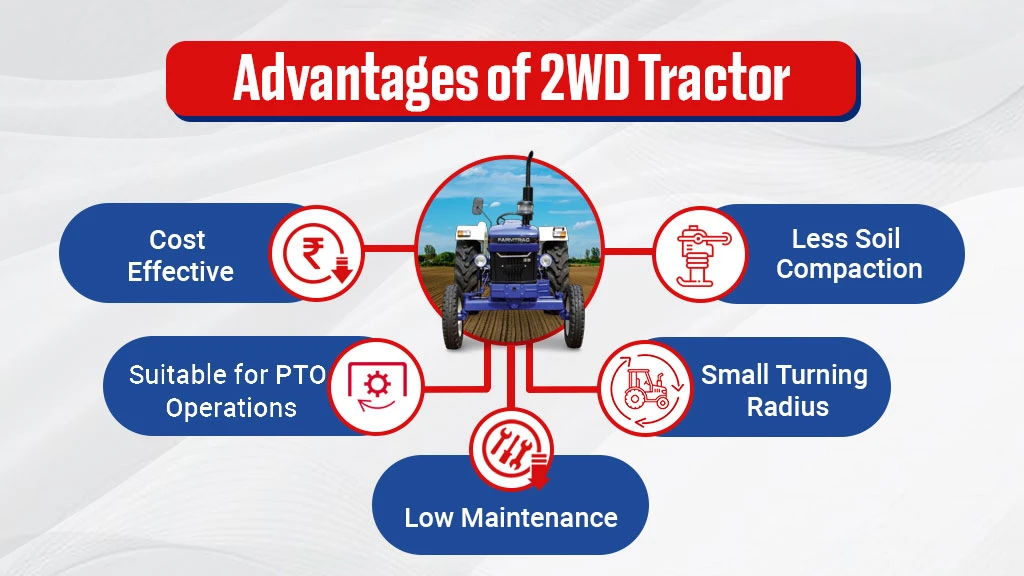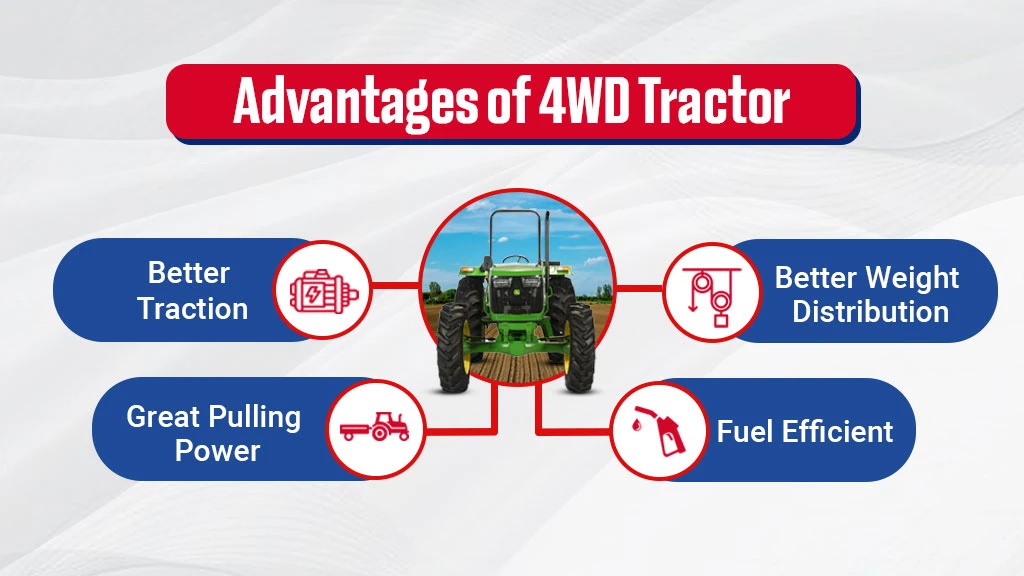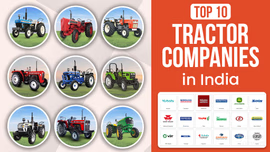2wd vs 4wd Tractors: Which is Best for Your Farms?

Table of Contents
- Introduction
- What is a 2WD Tractor?
- What is a 4WD Tractor?
- Comparison of 2WD and 4WD tractors
- How to Choose the Tractor for Your Farm?
Introduction
4WD technology is not extremely old in India but has emerged as a game changer in modern farming. It was first introduced in mini tractors, however, with time it has been introduced in almost all HP categories in every brand and model. Initially, 4WD tractors were not preferred over 2WD in India by the marginal farmers due to their higher costs. It was also believed that 4WD tractors are not fuel efficient and do not give much mileage. However, gradually, more farmers started shifting towards 4WD tractors due to their productivity and efficient performance in difficult tasks like Puddling. It is important to note that all 4WD tractors can shift to 2WD using the mode shifting lever provided in the tractor. Both 4WD and 2WD have their benefits and limitations. To learn about them we first need to understand the actual real-life differences between the 2WD and 4WD tractors are. Let’s understand these two types of tractors in detail.
What is a 2WD Tractor?
The 2WD or rear wheel drive tractors are propelled by the two rear wheels. In a 2WD tractor the engine only powers one of the two axles. In simple terms, 2WD tractors are the tractors in which only the two rear wheels are engine powered while the other two wheels are a part of the steering system. This means that the tractor’s engine distributes power to only two wheels. The 2WD tractors are highly suitable for primary farm operations like sowing seeds, spraying fertilizers and pesticides, topping the pastures, etc.
What are the Advantages of a 2WD Tractor?

- Cost Effective: The prices of the 2WD tractors are comparatively less than 4WD tractors. This makes them a budget friendly option for Indian farmers.
- Less Soil Compaction: The tyre size of 2WD tractors is comparatively smaller than 4WD tractors due to which while using the seed drill they may cause less soil compaction than 4WD tractors. It is an advantage because the more soil compaction can affect the quality of seed germination and yielding.
- Suitable for PTO Operations: 2WD tractors are suitable for PTO operations and implements like thresher, rotavator, mulcher, PTO driven generators, etc.
- Small Turning Radius: 2WD tractors above 40 HP may have a small turning radius due to which they can easily turn in small areas. Therefore, they are suitable for small scale farmers.
- Low Maintenance: 2WD tractors are less complex as they are not as advanced as 4WD tractors. They have less components and elements due to which their maintenance is low.
- Suitable for Haulage: The tractors are used primarily in 2WD mode in case of haulage. So, if you wish to buy a tractor specifically for haulage then a 2WD tractor is the right choice.
What are the Limitations of a 2WD Tractor?
- Less Traction: 2WD tractors offer less traction and stability. They are prone to slippage. Therefore, they are not suitable for wet, muddy, or sloped lands.
- Limited Pulling Capacity: Owing to less traction and only rear powered wheels, 2WD tractors offer a limited pulling capacity and are not suitable for heavy implements.
What is a 4WD Tractor?
4WD tractors are the tractors in which all of the four wheels are engine powered. The tractor’s engine powers both the axles. Since both axles and all four wheels transfer power to the ground, it can easily plough through hilly terrains, get unstuck from mud or tackle rugged off-road terrain. The 4WD tractors have better weight distribution, traction, and pulling power.
What are the Advantages of a 4WD Tractor?

- Better Traction: 4WD tractors offer enhanced traction and less slippage as the engine power is transmitted in all four wheels of the tractor. This makes the tractor suitable for wet-land applications like puddling.
- Better Weight Distribution: The weight distribution in 4WD tractors is better than 2WD tractors. They are more balanced and offer better stability due to which they do not experience tractor lifting issues.
- Great Pulling Power: The improved traction allows 4WD tractors to pull heavy loads and implements without getting stuck or losing traction.
- Fuel Efficient: The 4WD technology offers more traction and less slippage. Owing to this, the 4WD tractors perform different farming operations in less time than 2WD tractors. Therefore, 4WD tractors are more fuel efficient.
- Suitable for Rough Terrains: 4WD tractors can efficiently operate in hilly regions. They are also suitable for puddling and spraying in muddy fields.
- Versatile: 4WD tractors can perform all kinds of farming operations rather than just some basic operations. They work efficiently and are compatible with a wide range of implements like Hydraulic plough, super seeder, loader, dozer, etc. which makes them versatile.
What are the Limitations of a 4WD Tractor?
- High Maintenance: The front axle of a 4WD tractor requires timely maintenance otherwise it can lead to oil leakage issues.
- More Soil Compaction: The 4WD tractors come with bigger tyres due to which the soil compaction increases. It decreases the aeration of soil and slows the decomposition process which can directly affect the productivity of soil.
Comparison of 2WD and 4WD tractors
|
Factor |
2WD Tractor |
4WD Tractor |
|
Fuel Efficiency |
2WD tractors require more time and effort to perform a heavy-duty task which leads to more fuel consumption. |
4WD tractors can effortlessly complete all farming operations in less time which makes them more fuel efficient. |
|
Suitable for Slopes |
2WD tractors suitable for flat terrains rather than slopes due to less traction. |
4WD tractors are suitable for slopes due to better traction. |
|
Applicability |
2WD tractors are suitable for sowing, spraying, and PTO operations. |
4WD tractors are suitable for everything and beyond what 2WD tractors can perform. |
|
Technological advancement |
2WD tractors require additional investments for accessories which are not required in 4WD tractors to unlock their full potential. |
4WD tractors come equipped with advanced features and give best results without additional investments. |
|
Price |
2WD tractors have less price and are cost-effective. The maintenance cost is comparatively less than 4WD |
4WD tractors have high prices due to their ability to generate more power and traction. But they are considered a safe investment in the long run. |
How to Choose the Tractor for Your Farm?
Based on all of the information covered above in the blog, we can infer that choosing the tractor depends on your farming requirements. For example, 2WD tractors are more budget friendly and ideal for primary farming operations in usual field conditions because they require less traction and pulling power. Whereas, 4WD tractors provide better stability, traction, pulling power, versatility which makes them suitable for slopy terrains, wet land applications, etc. However, they are high maintenance and slightly expensive. So, based on your crop, farm, and budget requirements you can choose the appropriate tractor.
Visit Tractorkarvan to explore and purchase a 2WD or a 4WD tractor of your choice at affordable prices.


Related Blogs












